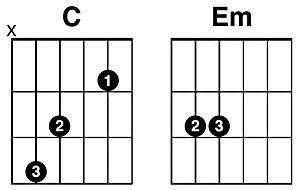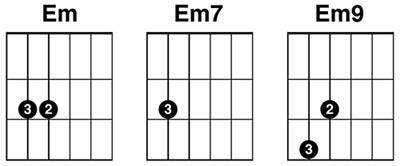Easy Eleanor Rigby
A Couple Chords, A Few Notes
& Some Finger Movement
Only two chords?
You only need two chords to play this easy Eleanor Rigby version. Even better, the two chords you need to know are two of the chords that many beginners learn very early. So, I'll add a few notes to give the song more of it's original flavor and teach you a few notes on the fretboard.
By the way... Start-Playing-Guitar.Com is all about learning to play the guitar. One way to accomplish this is to explain how to play songs that most people are familiar with. My intent is to help you play guitar, not to reproduce copyright materials. The simplified versions here are my own work, intended for private study and self-education while taking ease of play into account. If you want a copy of the as-recorded sheet music, you can get it here Eleanor Rigby Sheet Music.
The Chord Forms
If you've been learning guitar for any amount of time, you already know the C-Major and E-minor chords. If guitar is brand new, take heart, these are two of the easiest chords to play.
From here on I'll use the shorthand versions of these chords, so C always means C-Major, and Em always means E-minor.
Here are the chord forms for the easy eleanor rigby version of this song:
 |
For the C chord, your index finger (1) is on the first fret of the B string; your middle finger (2) is on the second fret of the D string; and your ring finger (3) is on the third fret of the A string. The 'x' above the lower-E string means that string is not strummed. Some people strum the lower-E string but kill the sound by pressing their '3' finger lightly against it.
The Em chord is played by placing your middle and ring fingers on the second fret of the A and D strings. You can exchange your '2' and '3' fingers if you like. Many players would see the Em following the C and simply move their '3' finger back while lifting their '1' finger. The '2' finger doesn't move (it acts as a pivot point), and... Voila! Your at Em!
Try strumming the C, excluding the lower-E string... then try deadening the lower-E with your '3' finger. Try moving from C to Em using the forms pictured... then try moving the '3' finger back, lifting your '1' finger and using '2' as a pivot point. Use whichever set of forms is most comfortable and allows you to flow smoothly from one chord to the next.
Ready To Play? Let's Go!
First, try the easy Eleanor Rigby version with only the C and Em chords. Here's how the chords fit into the lyrics:

Pretty straight forward. With only two chord changes it's fairly easy to learn this version, but you may soon tire of the repetition of the Em chord. So, what can we do to give it more flavor?
Moving Fingers... Descending Bass
With just a little effort, we can add a descending bass line and liven up the song.
We'll use the Em form with the '2' and '3' fingers switched what is typically shown, and use two new forms: Em7 and Em9. The new Em form and these new chords make the bass line easier to accomplish.
 |
Em7 is shorthand that tells you to play the Em chord and add the seventh note of the scale. For Em, the seventh note is D. Conveniently, the D string is right where you have your '2' finger (with our reversed-finger version of the Em chord). So, simply lifting your middle finger puts you in the Em7 position.
Em9 is, therefore, shorthand that tells you to play the Em chord with an added ninth note of the scale. For Em, the ninth note is F. This too is relatively convenient for our version of Em. Simply slide your '3' finger up the fretboard one fret.
When you put these three chord forms together in the Chorus, you're playing the descending bass notes D...F...E, and adding some flavor to this easy Eleanor Rigby version of the popular Beatles song.
Here's the new easy version... Enjoy!



